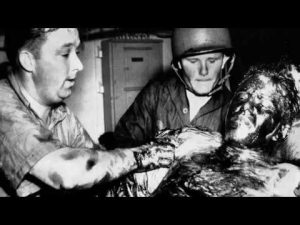
Finally, the nation heard some good, if bittersweet, news.
On Saturday, billionaire Paul Allen announced that a search team he funded had finally found the long-lost USS Indianapolis.
We've located wreckage of USS Indianapolis in Philippine Sea at 5500m below the sea. '35' on hull 1st confirmation: https://t.co/V29TLj1Ba4 pic.twitter.com/y5S7AU6OEl
— Paul Allen (@PaulGAllen) August 19, 2017
The World War II cruiser lies at the bottom of the Pacific at a whopping depth of over 18000 feet. She has rested there, undiscovered, for over 72 years after being sunk by a Japanese submarine.

Allen said, in a statement:
“To be able to honor the brave men of the USS Indianapolis and their families through the discovery of a ship that played such a significant role in ending World War II is truly humbling.”
“As Americans, we all owe a debt of gratitude to the crew for their courage, persistence and sacrifice in the face of horrendous circumstances. While our search for the rest of the wreckage will continue, I hope everyone connected to this historic ship will feel some measure of closure at this discovery so long in coming.”
The sinking of the USS Indianapolis is a tale of a secret mission and naval negligence. It’s also a saga of men adrift at sea, suffering sun, starvation, dehydration, and shark attacks. Lots and lots of shark attacks.

In late July, 1945, the cruiser USS Indianapolis left the island of Tinian, where it had completed its secret mission. And the mission? To deliver components of “Little Boy,” the atomic bomb dropped a short time later at Hiroshima. However, because of the secrecy involved, the Indianapolis did not have an destroyer escort, even though her captain, Charles McVay, requested one. Furthermore, the Navy didn’t tell McVay about enemy sub activity in the area. Worse yet, the Indianapolis didn’t even have sonar for detecting submarines. Surrounded by subs, the ship was completely alone.

Then the attack happened. The first torpedo hit just after midnight on July 30, and then a second struck. The Indianapolis sank in only 12 minutes. Of the nearly 1200 man crew, 900 survived and entered the water. But the worst was yet to come.
The official report claims that the ship sank so fast that it didn’t send a distress signal, or deploy adequate survival gear. As a result, the survivors endured four days of bobbing in the water in water-logged life vests. One sailor described how the mens’ tongues swelled and lips split from dehydration and the relentless sun. Men also went mad from thirst and drank toxic salt water, dying rapidly.

Another survivor said:
“You could barely keep your face out of the water. The life preserver had blisters on my shoulders, blisters on top of blisters. It was so hot we would pray for dark, and when it got dark we would pray for daylight, because it would get so cold, our teeth would chatter.”
And then the sharks came.
Hundreds of sharks swarmed the wreckage of the Indianapolis, attracted by the explosions and the blood in the water. At first, they fed only on dead bodies, but after a while they became attracted to the thrashing of the living men. They attacked the wounded and bleeding. On top of that, men couldn’t even open survival cans of Spam — the action quickly attracted even more sharks.
That ordeal, the worst shark attack in history, was starkly described in the 1975 movie Jaws, when the character Quint, played by Robert Shaw, relates the horror of the shark attacks:
Finally, on the fourth day, a Navy plane spotted some of the survivors. Later, another larger seaplane circled overhead. Finally ships raced to the rescue of the dying men who were floating in small groups around the ocean. One man, by that time barely conscious, saw his rescuers and thought they were angels coming:
“It got dark and a strong big light from heaven, out of a cloud, came down, and I thought it was angels coming. But it was the rescue ship shining its spotlight up into the sky to give all the sailors hope, and let them know that someone was looking for ’em.
“Sometime during the night, I remember strong arms were pulling me up into a little bitty boat. Just knowing I was saved was the best feeling you can have.”
Of the men who entered the water, only 317 survived the agony of starvation, dehydration, and shark attacks.

Today only nineteen of those men are known to still be living. Perhaps the discovery of the Indianapolis will provide some closure for these very old heroes.
I have a 92 year old friend who was stationed on a destroyer that was one of the rescue ships. He says he still has nightmares from time to time recalling the men and bodies he helped recover. He also said that most of the men attacked by the sharks were bare legged.
The photos seem to show the Indianapolis is very well preserved. I hope its great depth protects it from illegal salvage.
3 Comments